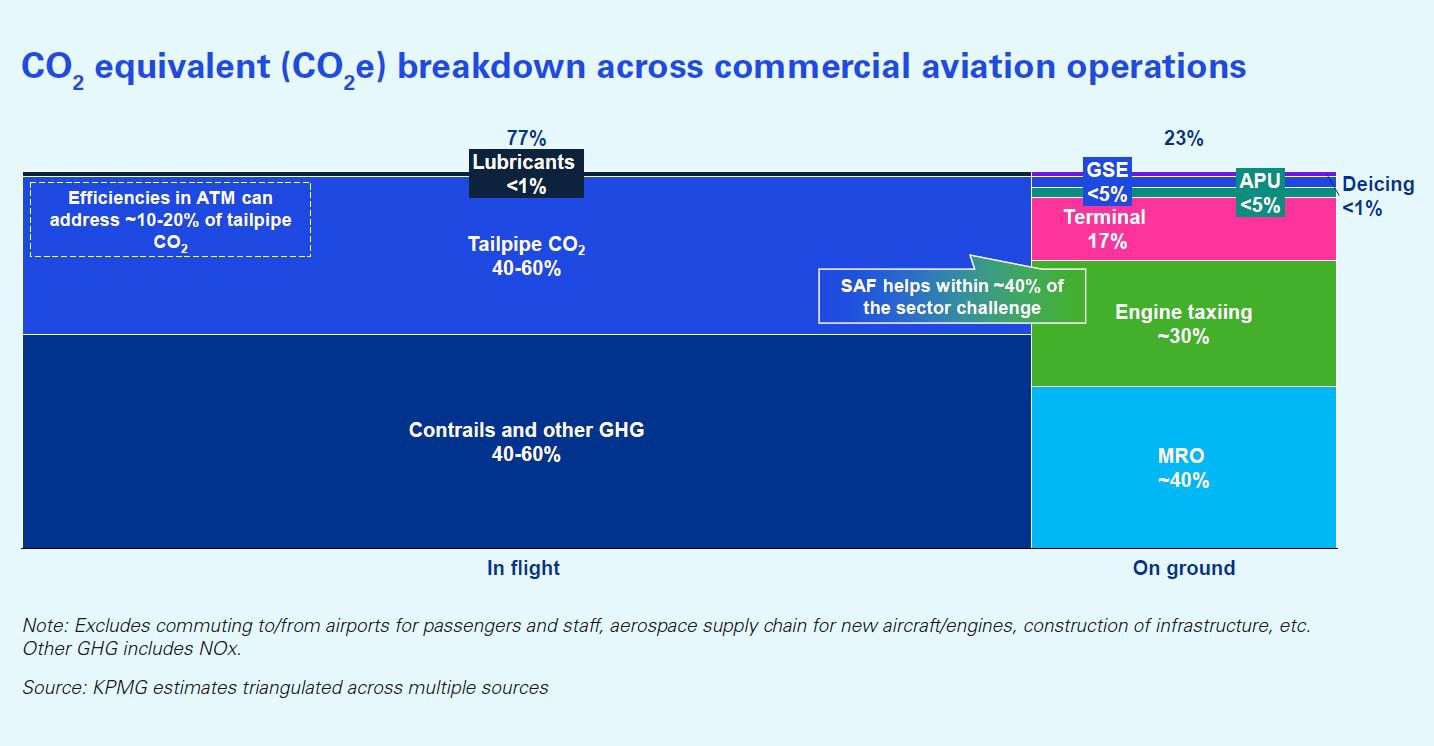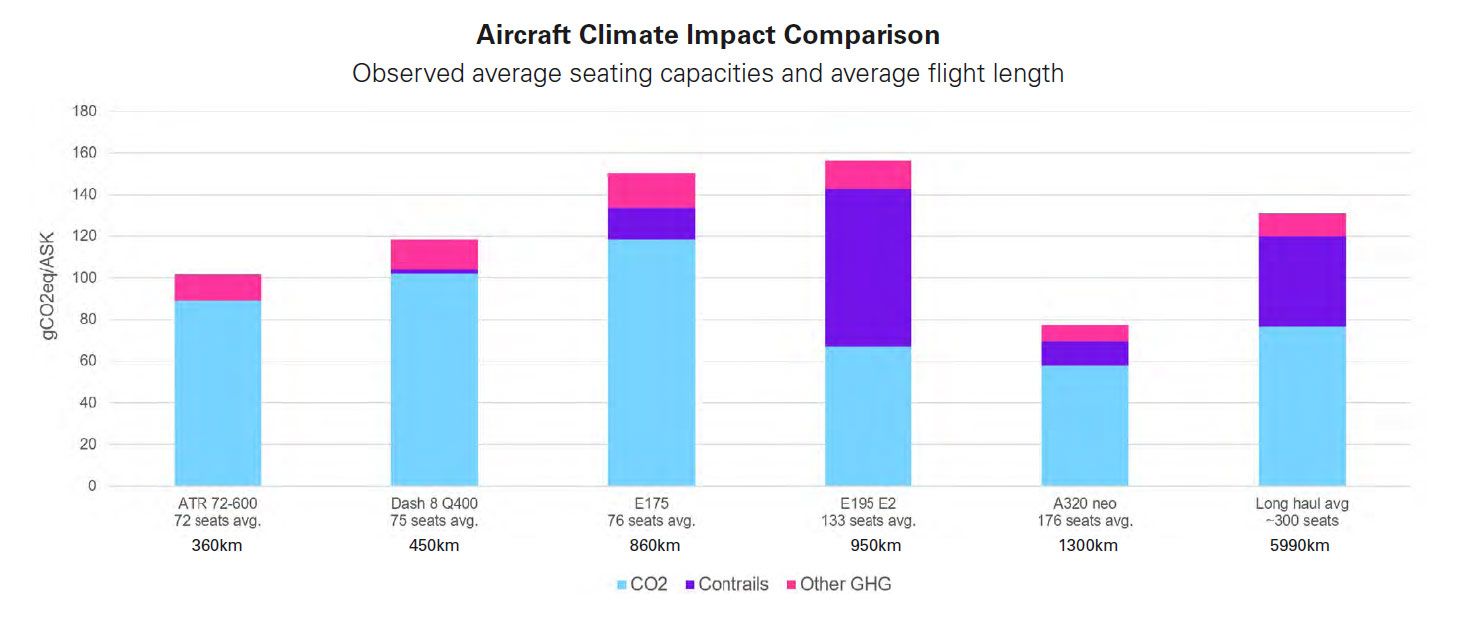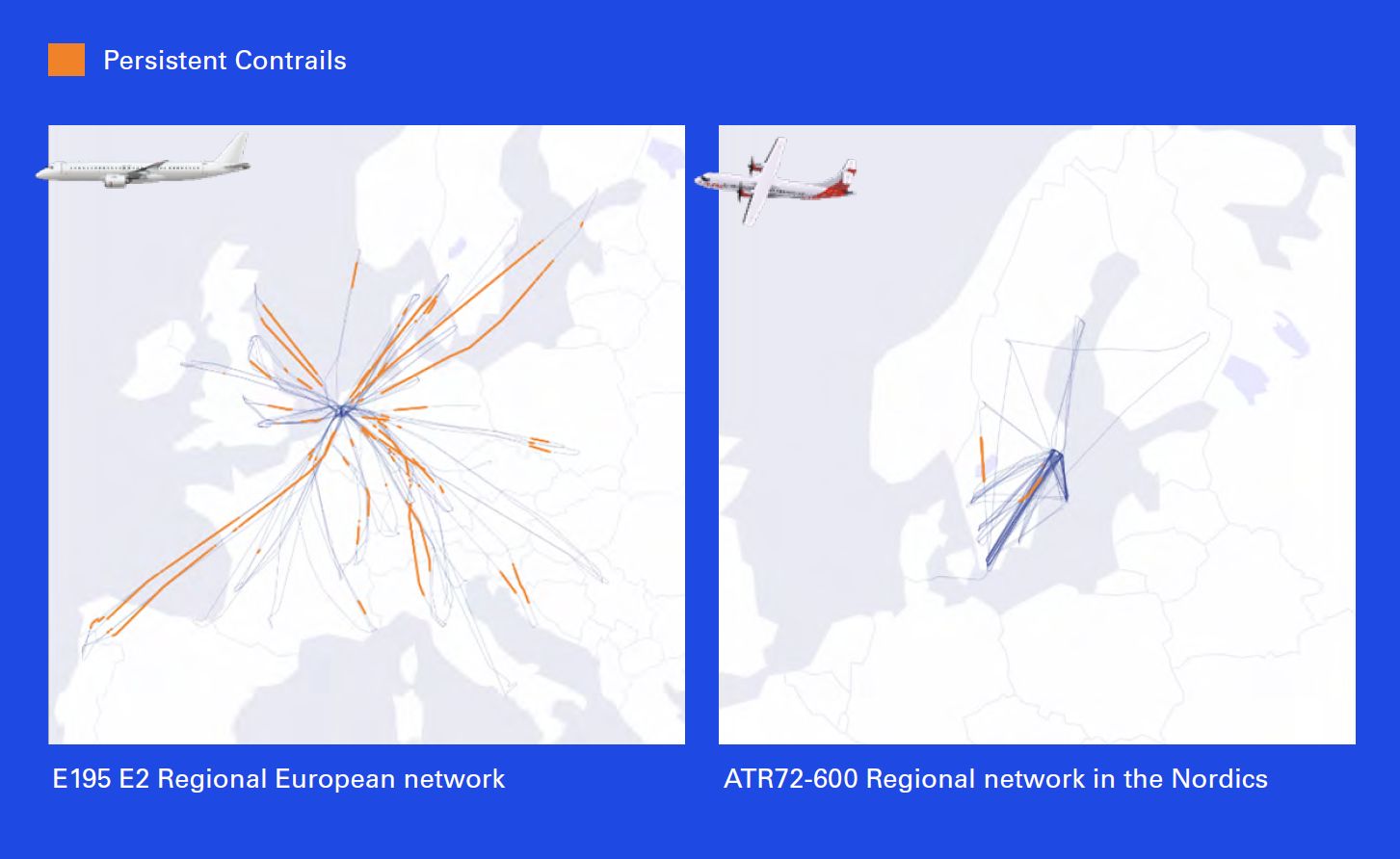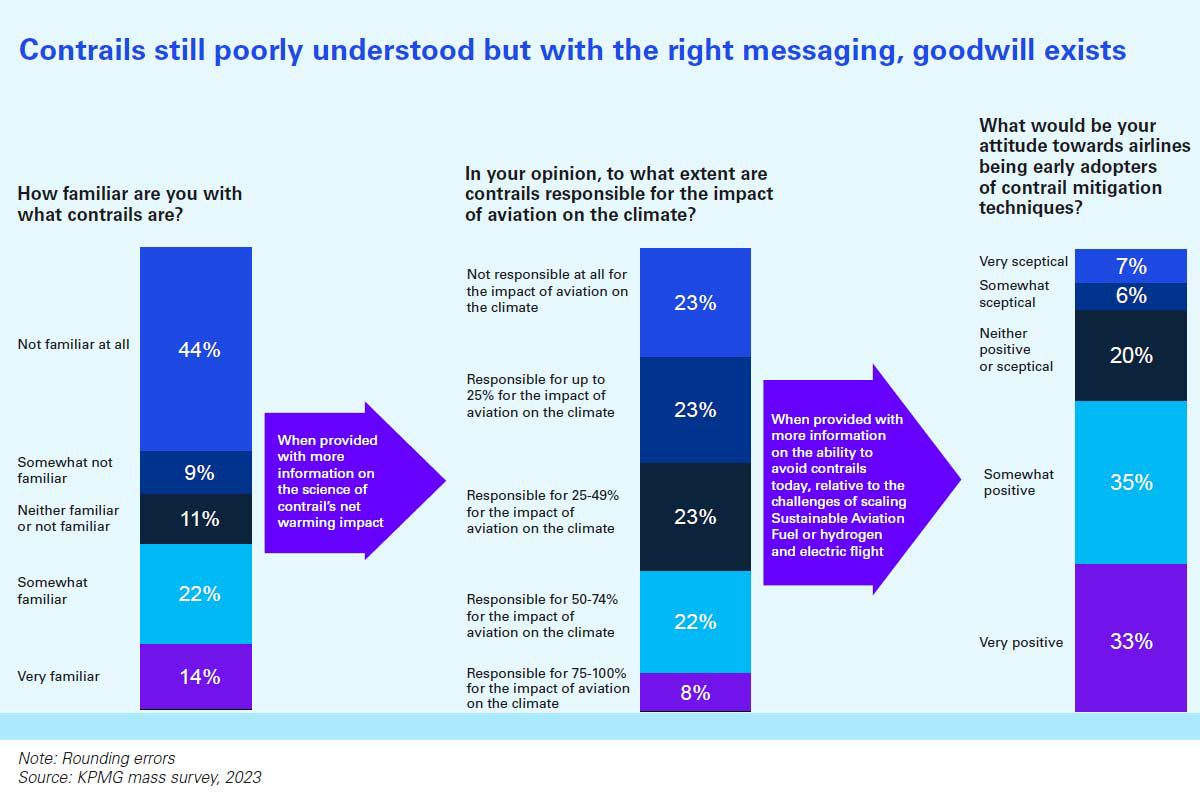Aviation 2030 series
Unlike in-flight emissions from fossil fuels, which require massive evolution in replacement technologies such as hydrogen, electric, and scaling of energy-intensive Sustainable Aviation Fuels, contrails can be addressed with today’s technology, offering the sector a golden opportunity for genuine green proactivity that goes far beyond the tokenism it is often accused of.
Christopher Brown and our Strategy team take a look at how contrail impact can be mitigated, below.
Background
In the race to net zero, few sectors have a tougher challenge than aviation, which accounts for around 2.5% of global CO2 emissions from human activity, but around 4% of total anthropogenic warming impact. The difference between these two figures reflects the extraordinary complexity of the sector’s challenge.
Already dealing with their fair share of other challenges, airlines face a mammoth task to achieve their net zero targets, and need all solutions on the table. Talk to date has focused mostly on dealing with in-flight CO2 emissions via Sustainable Aviation Fuels as well as niche applications for electric, and hydrogen technologies.
The challenge is that each of these solutions are decades away from scaling. But forgotten in many of the (CO2 ) net zero conversations is a non-CO2 challenge, albeit a challenge that offers far more immediate upside opportunity.
In this paper we focus on contrail management – an overlooked and potentially cost-negative opportunity for sustainability that can be delivered with today’s technology.

How big is the opportunity?
The mechanism by which contrails exacerbate warming has been understood for some time, for example, NASA’s Patrick Minnis highlighted their warming effect in the 1990s.1 Under certain atmospheric conditions, they persist as cirrus clouds, which cause cooling when they reflect incoming sunlight back into space, and warming when they trap heat radiating from the earth’s surface.
Whilst the cooling effect can only work during daylight, the warming effect operates 24/7, and their net impact is – in the absence of contrail management – to raise temperatures.
But by how much? More recently, scientists have learned more about the size of the impact. Whilst estimates remain variable and fraught with uncertainty, they tend to agree that it is very significant.
According to Dr Edward Gryspeerdt at Imperial College London, contrails account for more than half the total warming impact of all aircraft2, whilst the Intergovernmental Panel on Climate Change’s (IPCC) 2022 report says that contrail-cirrus cloud coverage causes a combined ERF (effective radiative forcing) close to 60% of the current net ERF of global aviation.3
Others, like the EU ETS, followed by Google among others, quote more conservatively around 35%. In a recent article, Lee et al. raise concerns about the ability of weather forecasts to identify ice supersaturated regions and guide aircraft deviations.4
Ironically, the uncertainty is less to do with understanding the warming effect of contrails, and more about our lack of understanding as to how long CO2 lingers in the atmosphere, hence impacting the conversion factor of contrails into CO2 equivalency.
In plain English, the impact of contrails is either big, or very big. Unlike CO2 emissions, however, only a small fraction of flights lead to contrails. This makes contrails aviation’s single biggest opportunity to reduce its climate impact.5
Yet the International Air Transport Association’s net zero goals don’t even factor contrails into their starting position, leading to indifference (and even resistance) across much of the industry. This is a missed opportunity, not least in the public relations battle that aviation will continue to face for decades to come.
As contrails have gained more public awareness, industry push back has been on display, with some sector participants and some academics, without access to some of the leading real world data on the topic, arguing that the uncertainties, and need for more research, should push the issue out before real world interventions are warranted - much as the sector procrastinated on CO2 reduction for several decades.
In contrast, this paper argues that in certain, specific scenarios (such as winter night flights over the less airspace-constrained North Atlantic), existing real world data already provides a genuine case for proactive sector action.
Meanwhile, in less certain circumstances, further study can help define the parameters of useful intervention. As the scale of intervention and costs involved are minimal, such contrail management does not distract from the sector’s desire to scale SAF supply.
Quicker wins
Not only is the contrail impact material under the more conservative assumption, but the most warming of contrails could be solved for now. Unlike in-flight emissions from fossil fuels, which require massive evolution in replacement technologies such as hydrogen, electric, and scaling of energy-intensive Sustainable Aviation Fuels, contrails can be addressed with today’s technology, offering the sector a golden opportunity for genuine green proactivity that goes far beyond the tokenism it is often accused of.
And with the EU ETS requiring non-CO2 impact reporting from 2025, airlines with EU route exposure have every reason to grasp the nettle. Mitigating contrail impact is relatively straightforward, relative that is, compared to the other tools at aviation’s disposal like air space redesign, new propulsion certification, or scaling new fuels supply.
Since contrails are far more likely to form under particular atmospheric conditions (namely pockets of higher levels of moisture and lower temperatures), small adjustments in flight altitudes can avoid such conditions.
This need not be as massive an undertaking as it sounds, since research suggests that ~80% of the total contrail warming impact is caused by only ~2% of flights, with longhaul and night flights being the main concern.6
Whilst flights targeted for mitigation may face a fuel burn penalty for amending their flight routes, it is likely to be trivial – 2% according to a recent trial by Google and American Airlines,7 and no more than 0.5%, according to Ian Poll, Royal Aeronautical Society Past President and Emeritus Professor of Aerospace Engineering at Cranfield University, a figure corroborated by real-world adjustments recommended by contrail modelling specialist SATAVIA in trials backed by the European Space Agency with over 10 airlines, which has found on average that a fuel burn difference equating to ~100kg CO2 is necessary to mitigate 52T CO2e.
Keep in mind this is a per adjusted flight route – since even many long-haul flights will not create contrails on a given day, an airline-wide fuel burn penalty is likely to be more in the region of 0.01% of airline fuel total.8
At this level, any such penalty would be significantly less than the typical fuel excess already burned routinely by airlines pursuing maximally profitable operations, which depend on a range of factors including flight time, air traffic management charges, crew hours, aircraft rotation requirements, air traffic congestion time slots, etc.
Clear incentives, clear demand
Why are airlines not already doing this? Largely because climate policy focus has excluded non-CO2 warming impacts, giving airlines little incentive to deal with contrails.
All sectors ultimately require a combination of carrots and sticks to change behaviors, and aviation is no different, with many players arguing that avoided contrail warming needs to have a clear monetary value.
A prominent example is the aforementioned SATAVIA, a UK startup that has developed a platform to optimize flight paths for contrail mitigation, subsequently converting the modelled avoidance into future tradable carbon equivalent credits (Certified Mitigation Outcome Units or CMOUs).
Its methodology has received concept approval from Gold Standard, the certification body established by the World Wildlife Fund, paving the way towards the development of what it thinks is an over USD10bn market, with several more airline customers signed up and in trials.
At the same time, Delta is working with MIT to study contrail mitigation9, and American Airlines has recently teamed up with Google to trial AI-led solutions to the same problem,10 whilst startups like software company Estuaire are aiming to provide airlines with the data they need to understand their contrail impact.
Case study #1: Estuaire
Estuaire is a software platform dedicated to monitoring and mitigating aviation’s climate impact. It adopts a detailed flight-by-flight analysis considering actual aircraft trajectories. This approach computes the climate impact of each flight, encompassing CO2 emissions and other factors like contrail radiative forcing.
Additional emissions such as nitrous oxides, soot, sulfur, and water vapor are categorized as “Other Greenhouse Gases.” Examining flight trajectories allows for a more precise understanding of contrail formation.
Multiple variables like flight timing, location, seasonal variations, weather, aircraft, and engine types significantly influence contrail formation. With this comprehensive dataset, non-CO2 radiative forcing effects are assessed more accurately.
Understanding the non-CO2 impacts of different aircraft types is crucial for informing future fleet strategies. An analysis was conducted comparing various aircraft types using data from around 20 individual aircraft (identified by tail numbers) for each type.
The analysis leveraged detailed information including aircraft and engine models, specific flight routes, weather conditions, and a contrail model called CoCiP. This comprehensive approach resulted in an overall climate impact measured in grams of CO2 equivalent per available seat kilometer.

Regional turboprops like the ATR 72-600 are extremely unlikely to form contrails. Indeed, they operate at altitudes below 25,000 feet, avoiding the Ice Supersaturated Regions (ISSRs) where contrails form and eventually persist.
With lower seat capacity, they exhibit slightly higher CO2 emissions per available seat kilometer than larger aircraft. However, it is also worth noting that if we would restrict this analysis to shorter flights, CO2 emissions would show significant improvement, often positioning turboprops to have the lowest fuel burn per available seat kilometer out of all types.
An interesting observation arises with new-generation regional jets, showcasing commendable fuel efficiency but unexpectedly high contrail contribution. This can be attributed to slightly longer flights with heightened altitudes and relatively elevated levels of black carbon emissions from the engine, as documented in the ICAO aircraft engine
emissions database.
The contrail model used exhibits a high sensitivity to black carbon formation. As those black carbon particles act as ice nucleation sites behind the aircraft, increased emissions usually correlate with a longer contrail lifetime and radiative forcing.
Narrowbody jets like the A320neo stand out as top performers when looking at average climate impact per available seat kilometer. The A320neo engine mix does generate contrails, but again, the majority of these dissipate quickly because little black carbon soot is released from the average A320neo engine combustor, resulting in minimal contrail
persistence.
Beyond black carbon emissions considered in the contrail model, ongoing research investigates the potential of alternative engine exhaust particles, such as ions and oil residues, in initiating cloud formation. The observed engine disparity might re-balance in the future.
Within the long-haul category, a mix of old and modern Airbus and Boeing widebodies were chosen. There, another parameter comes into play. The high proportion of night flights amplifies the climate impact of persistent contrails, as contrails mostly warm temperatures at night, when they trap outgoing Earth radiations that would have normally gone
into space.
| Aircraft type Seats Engine |
ATR 72-600 72 seats PW127M/XT |
Dash 8 Q400 75 seats PW150A |
E175 76 seats CF34 |
E195 E2 133 seats GTF |
A320 neo 176 seats LEAP & GTF |
Long haul avg ~300 seats Various |
|---|---|---|---|---|---|---|
| Avg CO2/flight [tons] | 2.3 | 3.5 | 7.7 | 8.4 | 13.4 | 152.6 |
| Avg contrails/flight [tonsCO2eq*] | 0.004 | 0.08 | 1.0 | 9.5 | 2.7 | 87 |
| Avg yearly CO2 [tons] | 3,750 | 5,640 | 12,220 | 13,910 | 21,590 | 81,430 |
| Avg yearly contrails/flight [tonsCO2eq*] | 7 | 120 | 1,590 | 15,710 | 4,340 | 46,440 |
Examining absolute emissions per flight and per year provides an additional lens. Aircraft lessors typically obtain reports detailing the number of flight cycles flown by their assets within specific periods.
The table provided offers insights into how these cycles correlate with average climate impact. Away from theoretical fuel burns, the values above are based on the real utilization of batches of 20 tails per aircraft type.
Leveraging flight maps sourced from the Estuaire platform, the sensitivity of different aircraft types to contrail formation is clear.

In the illustration, two aircraft are compared focusing on a subset of flights — 10 per month — to enhance visibility. Each orange dot denotes the formation of a contrail with a high probability of persistence. Noticeably, the lower cruise altitudes of the ATR 72-600 almost deletes any contrail formation potential.
Models are available for aircraft manufacturers, lessors and airlines to start estimating and reporting non-CO2 effects like contrail formation. This underscores a commitment to comprehensive climate accountability in aviation.
This transparency aids in understanding the full environmental impact of each aircraft type, instead of focusing on fuel burn per available seat kilometer, guiding decisions towards more sustainable practices across the aviation value chain.
Case study #2: SATAVIA
SATAVIA , based in the UK’s Cambridge, has pioneered commercially attractive contrail management, citing the need to address a climate challenge accounting for up to 2.4 billion tonnes of carbon dioxide equivalent impact each year.
To this end, the company has developed a methodology for airlines to earn credits for mitigating climate warming caused by aircraft-generated clouds, a kind of short-lived climate forcer (SLCF). The principles are simple, even if the technology is not.
SATAVIA uses granular climate modeling to predict specific areas in which persistent contrails are likely to be created. Based on this analysis, it recommends slight modifications to relevant flight trajectories, enabling aircraft to avoid such warming regions. It can then use post-flight data analysis to quantify achieved climate savings.
The methodology has received concept approval from Gold Standard, the World Wildlife Fund-founded global standards body, enabling future issuance of SATAVIA’s provisional Certified Mitigation Outcome Units (CMOUs) for non-CO2 aviation emissions avoided via contrail management activity.
This positions CMOUs as incentives for aircraft operators to undertake contrail management in advance of regulation and accelerate progress towards lower climate impact flying. The company is already working with Etihad on a commercial basis, alongside POCs with KLM and KLM Cityhopper and European Space Agency-funded trials with multiple other operators, saving thousands of CO2 equivalent tonnes to date.
That real world activity also provides evidence to counter claims that ‘more study is required before action is taken’. From the below data sample, it it is evident certain conditions (even under the most conservative of CO2 conversion assumptions, and real world fuel burn penalties) warrant action now.
For other more marginal cases, further research will indeed help clarify when interventions are and are not warranted. According to SATAVIA figures, assuming a value of £30 per ton of CO2e avoided, an airline can expect to generate a benefit of 5-7x its mitigation cost per modified flight.

Despite the compelling case to be made for contrail management, our research suggests limited awareness within industry circles, not to mention the wider flying public. KPMG recently surveyed a statistically significant sample size of frequent flyers globally. This research shows that low awareness can turn to positive enthusiasm for action.


Making it happen
According to Professor Ian Poll: ‘if civil aircraft were to actively avoid all persistent contrail formation, aviation’s daily climate impact would be halved at a stroke.’ Longer term, Poll and others believe it may even be possible for aviation to produce a net cooling impact through the active management of daytime contrails and elimination of nighttime contrails.
However, contrail management remains largely ignored as governments and media focus on decarbonization in the literal, narrower sense, and ignore wider warming effects. The EU’s reporting requirement on non-CO2 from 2025 starts to shift this dynamic, and several national governments are now pursuing their own discovery phase.
Airlines, still recovering from the pandemic, will eventually be forced or incentivized to pick what the Royal Aeronautical Society describes as the ‘really low-hanging fruit of aviation’.
Whilst a ban on persistent contrails is one option, enforcement is an obvious issue and commercial incentives such as SATAVIA’s tradable credits represent a perhaps more pragmatic solution.
Among the greenwashing potential of claims around “energy efficient fleets” and the likely inability of many airlines to secure sufficient Sustainable Aviation Fuel to meet their own commitments, contrail mitigation also presents a genuine opportunity for the sector to show it doesn’t need to wait for the regulatory stick to take action.
To conclude, we list some considerations by stakeholder type:
- Airlines
Almost all aircraft operators are likely to have some contrail climate impact, with the highest liabilities for long-haul flights, so avoid the temptation to kick this can down the road.- Avoid having your PR team push a narrative that ‘the science isn’t there yet’, with partners to baseline your contrail-related warming impact and the resulting opportunity to improve. Instead, work with partners to baseline your contrail-related warming impact and the resulting opportunity to improve.
- Investigate available contrail avoidance technologies available to in-flight and ground crews, including weather forecasting, instrumentation, and bespoke predictive platforms.
- Begin discussions with solutions providers, including the business case for implementation costs, operational modifications and fuel penalty, with potential monetary value of credits and public relations opportunity of early adoption.
- Policymakers
- Urgently and explicitly include non-CO2 warming effects in aviation industry climate policy, including impact reporting under national inventories/emissions trading schemes. Implement incentives for airlines to adopt contrail management as standard operating procedure (e.g. phased introduction of differentiated and dynamic airspace pricing).
- Consider territory-wide contrail mitigation potential through the integration of mitigation techniques in your airspace, likely in collaboration with your national Air Navigation Service Provider or regulator.
- Consider also coordinated, international introduction of additional sensors to build up a more comprehensive, real-time data lake of relevant atmospheric conditions.
- Study long-term potential for net cooling through deliberate contrail management.
- Developers and future operators of hydrogen flight
Get comfort that engine design and flight altitudes will not inadvertently contribute to contrails. While this is more relevant for larger, higher altitude aircraft than turboprop retrofits, hydrogen’s byproduct of water vapor has the risk of undermining the environmental credentials of hydrogen flight. Unless, that is, combined with daytime-specific efforts to create net cooling contrails. - Aviation regulators and Air Navigation Service Providers
Explore the collaborative potential with contrail management service providers for territory-wide integration.
Governments could begin by recognising that there is a rare opportunity here. Global mean temperature (GMT) rise is the problem, but GMT rise is not all about CO2 and this is especially true in aviation. Reducing the environmental impact of aviation non-CO2 effects needs to be given a high priority in policy making and regulation formulation. Financial or other forms of incentive need to be developed.
Get in touch
If you have any queries about the mitigation or management of contrails, please contact our Strategy team below. We look forward to hearing from you.
Christopher Brown
Partner, Head of Strategy
KPMG in Ireland
Kieran O'Brien
Partner
KPMG in Ireland
Shane O'Reilly
Managing Director, KPMG Sustainable Futures
KPMG in Ireland
Discover more in Strategy
Footnotes
- https://www.newscientist.com/article/mg15320750-200-wispy-trails-could-warm-the-earth/
- https://www.imperial.ac.uk/news/242017/clouds-created-aircraft-have-bigger-impact/
- https://www.ipcc.ch/report/ar6/wg3/downloads/report/IPCC_AR6_WGIII_Chapter10.pdf (PDF, 3.3MB)
- https://pubs.rsc.org/en/content/articlehtml/2023/ea/d3ea00091e
- https://www.ipcc.ch/report/ar6/wg3/downloads/report/IPCC_AR6_WGIII_Chapter10.pdf (PDF, 3.3MB); “It is important to note that the fraction of non-CO2 forcing to total forcing is not a fixed quantity and is dependent on the recent history of growth (or otherwise) of CO2 emissions (Klöwer et al. 2021).”
- https://www.imperial.ac.uk/news/195294/small-altitude-changes-could-contrail-impact/
- https://blog.google/technology/ai/ai-airlines-contrails-climate-change/; the trial nonetheless suggested that due to the small percentage of impacted flights, “the total fuel impact could be as low as 0.3% across an airline’s flights.”
- SATAVIA interview.
- https://www.travelweekly.com/Travel-News/Airline-News/Delta-MIT-study-contrail-avoidance
- https://blog.google/technology/ai/ai-airlines-contrails-climate-change/


